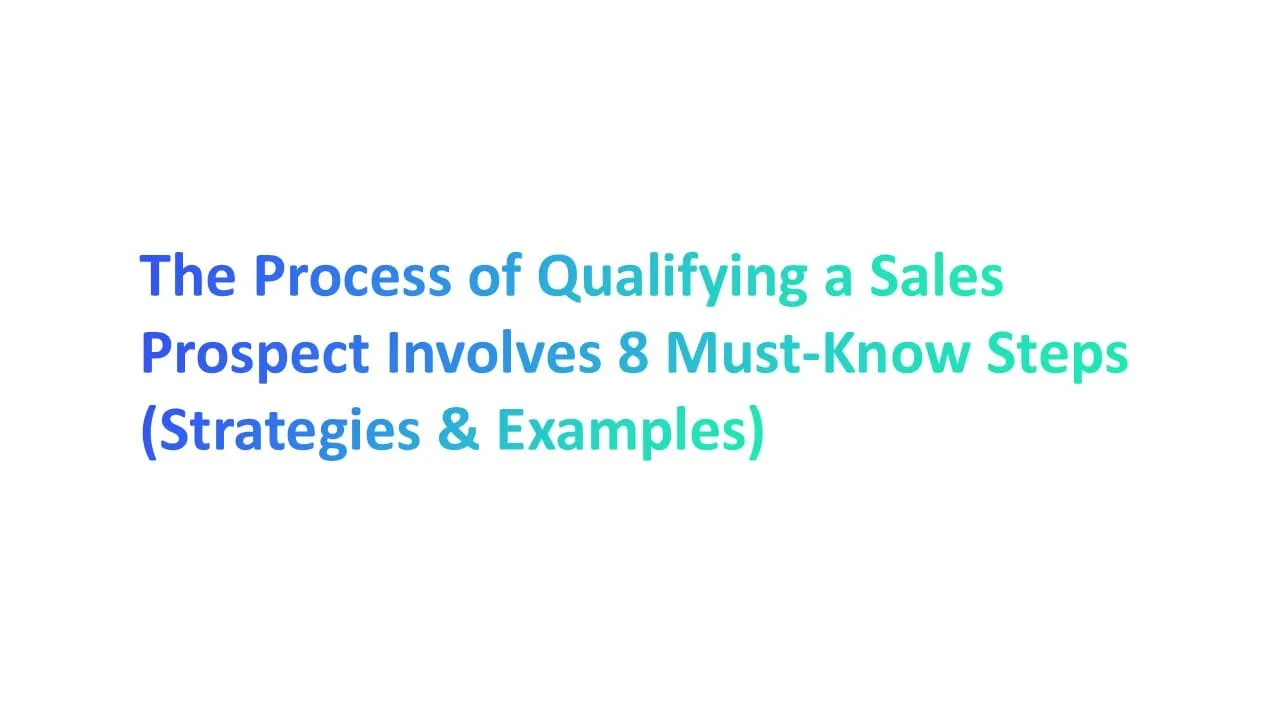Designing a strong marketing and sales strategy in your business plan is crucial for success.
Did you know companies that effectively align sales and marketing see a 38% higher sales win rate? (Source: MarketingProfs).
By integrating these two forces, you can improve lead quality, streamline processes, and boost your bottom line. Let’s explore how you can craft a winning strategy that drives real results.
What is a Sales and Marketing Plan?

A sales and marketing plan is a detailed strategy that outlines how a business will reach its target market, attract customers, and sell products.
It helps companies plan their marketing efforts and sales tactics together. Combining these two areas of marketing mix also makes it easier to set clear goals, track progress, and grow the business.
Importance of Integrating Marketing and Sales in a Business Plan
1. Enhances Lead Quality and Conversion Rates
- When marketing and sales teams share information, they can focus on the right audience.
- This means they can attract potential customers who are more likely to buy.
2. Streamlines Sales Funnel Efficiency
- A combined plan helps both teams understand the steps from marketing to sales. This makes the sales process smoother and faster.
- For example, when marketing brings in leads, sales can quickly follow up and convert them to buyers.
3. Provides Consistent Brand Messaging
- When marketing and sales teams share the same message, customers get a clear understanding of the product.
- It avoids confusion and helps build trust. Consistent messaging ensures that customers know what to expect, no matter who they speak with.
4. Shortens the Sales Cycle
- The sales cycle can be long and tiring. But when marketing gives sales good leads, the process becomes shorter.
- Sales teams can close deals faster because they are speaking to people who are already interested.
5. Reduces Customer Acquisition Costs
- When both teams work together, they save money.
- Marketing doesn’t waste money on ads that don’t work, and sales doesn’t spend time on leads that aren’t interested. This reduces the overall cost of gaining new customers.
6. Optimizes Product Development and Positioning
- Sales teams get direct feedback from customers. This helps marketing understand what customers like and don’t like.
- With this feedback, companies can improve their products and position them better in the market.
How to Make an Effective Sales and Marketing Strategy

Sales and marketing strategies should complement each other for a unified approach to reaching business goals.
1. Align Sales and Marketing Goals
Aligning sales and marketing goals means ensuring that both marketing collateral teams work towards the same objectives.
For instance, if the marketing team’s goal is to bring in 200 new leads, the sales team should be ready to convert those leads into customers.
Why is it important:
When sales and marketing teams are aligned, the sales planning process often becomes smoother and more efficient. This collaboration prevents confusion, reduces wasted effort, and ensures everyone is on the same page.
How to implement it:
- Set Clear Goals: Begin by holding regular meetings with both teams to set shared, measurable goals.
- Use Data and Tools: Use tools like CRM software to track lead progress and measure success.
- Regular Updates: Check in often to make sure that both teams are meeting their targets. This way, your marketing and sales plan can adapt quickly if needed.
2. Create Detailed Buyer Personas
A buyer persona is a detailed description of your ideal customer. It includes information like age, job, hobbies, and the problems they need solved. This helps identify your target audience and ensures your marketing efforts are effective.
Why is it important:
When you understand your target market, you can create better marketing messages and campaigns. This leads to attracting the right potential customers who are more likely to convert.
How to implement it:
- Collect Data: Look at your existing customers. Who are they? What do they like?
- Talk to Your Sales Team: Get insights on customer pain points and preferences from those who deal with customers directly.
- Build Profiles: Create profiles like, “Samantha, a 35-year-old small business owner who values affordable, easy-to-use software.”
- Use These Personas: Tailor your marketing messages to these personas to connect with your audience better.
3. Prioritize Lead Scoring and Qualification
Lead scoring is a system where you assign points to leads based on their actions, like visiting your website or downloading a product guide. Lead generation and qualification means determining if a lead is likely to become a paying customer.
Why is it important:
Not all leads are ready to buy. Lead scoring helps sales teams prioritize which leads to focus on, saving time and increasing sales efficiency.
How to implement it:
- Define Lead Criteria: Decide what makes a good lead for your business. It could be job title, company size, or engagement level.
- Assign Points: Give points for actions. For example, a lead who signs up for a free trial could get 20 points, while one who reads a blog post might get 5 points.
- Use Lead Scoring Tools: Tools like HubSpot and Salesforce can help automate this process, making it easier to manage leads.
- Focus Sales Efforts: Have your sales team focus on high-scoring leads first. This ensures they spend their time where it’s most valuable.
4. Embrace Multi-Channel Marketing
Multi-channel marketing means promoting your products or services across different channels. This can include social media, email, your website, TV ads, and even physical stores. The goal is to reach potential customers wherever they spend their time.
Why is it important:
People use different platforms every day. Some like to browse social media, while others read emails or visit stores. Using multiple channels helps you connect with more people.
How to implement it:
- Identify Key Channels: Find out where your target audience spends most of their time. For example, younger people might be more active on Instagram, while professionals could be on LinkedIn.
- Consistent Messaging: Make sure your marketing messages are similar across all platforms. This builds trust and helps people remember your brand.
- Use Automation Tools: Automation tools can help manage campaigns on different channels. You can send emails, post on social media, and track website traffic easily.
5. Implement a Sales Funnel Model
A sales funnel is the path a customer takes from learning about your product to buying it. It has different stages: awareness, interest, decision, and action. Each stage helps you understand how to market and sell to potential customers.
Why is it important:
The sales funnel helps you guide customers step-by-step toward buying. It makes the sales process more organized and effective. By understanding each stage, you can target your marketing efforts better and close more sales.
How to implement it:
- Awareness Stage: Start by creating ads and content that make people aware of your product. This could be blog posts, social media ads, or informative videos.
- Interest Stage: Once they are aware, share more details about the benefits of your product. Send them emails, provide testimonials, or offer free samples.
- Decision Stage: Here, you need to persuade them to make a purchase. Offer discounts, demos, or special deals.
- Action Stage: Make it easy for them to buy. Ensure your website checkout is simple, and give clear instructions. Follow up after the purchase to build a relationship.
6. Create a Content Marketing Strategy
Content marketing is the practice of creating useful and interesting content to attract and engage your audience.
This can be blogs, videos, infographics, or even podcasts. The goal is to educate and entertain, while subtly promoting your product.
Why is it important:
Great content builds trust and positions your business as an expert. People are more likely to buy from companies they trust.
How to implement it:
- Create Useful Content: Think about what your audience wants to know. Make blog posts, videos, or guides that answer common questions.
- Use SEO: Search Engine Optimization (SEO) helps your content show up when people search for related topics. Use keywords naturally in your articles to improve visibility.
- Engage on Social Media: Share your content on social media to reach more people. Encourage followers to comment, like, and share.
- Track Performance: Use tools like Google Analytics to see which content works best. This helps you improve and create better content in the future.
7. Use Social Proof and Case Studies
Social proof means showing that other people trust and like your product. This can be in the form of reviews, testimonials, or case studies. A case study is a story about how your product helped a customer solve a problem.
Why is it important:
People trust what others say about your business more than what you say. Case studies also give potential customers a clear picture of how your product can work for them.
How to implement it:
- Collect Testimonials: Ask your happy customers to share their experience with your product. You can feature these on your website and marketing channels.
- Share Case Studies: Write about how your product helped a customer. Show the problem, your solution, and the result. Make it easy to read and include quotes from the customer.
- Show Reviews: Display positive reviews on your website, social media, and other marketing materials. This builds trust and encourages new customers to give your product a try.
8. Monitor Competitor Strategies
Monitoring competitor strategies means keeping an eye on what other companies in your industry are doing.
It helps you understand what works and what doesn’t. This can be done by checking their marketing campaigns, social media, and even their website.
Why is it important:
Knowing your competitors' strategies can give you new ideas and help you improve your own sales and marketing section efforts.
If you see something that works well for them, you can try to do it better. It also helps you find gaps in the market that your competitors are missing.
How to implement it:
- Check Their Websites: Visit competitor websites regularly. See how they present their products, pricing, and special offers.
- Follow on Social Media: Watch what they post on platforms like Instagram, Facebook, and LinkedIn. Take note of which posts get the most engagement.
- Use Online Tools: Tools like SEMrush and Ahrefs can show you the keywords your competitors are targeting. You can also see which of their pages get the most traffic. Use this information to improve your marketing and sales plan.
- Create a Competitive Analysis: Write down what your competitors are doing well and where you think you can do better. Use this to guide your own marketing strategy.
9. Foster Continuous Collaboration Between Teams
Collaboration between teams means that sales, marketing, and other departments work together closely. This ensures that everyone is working toward the same goals and understands how to achieve them.
Why is it important:
When sales and marketing teams communicate well, the entire marketing and sales tactics process is more efficient. Continuous collaboration reduces misunderstandings and helps everyone stay on track.
Sales representatives need clear, consistent information from marketing to communicate effectively with potential customers.
How to implement it:
- Regular Meetings: Schedule regular meetings between sales and marketing teams. Discuss goals, share updates, and talk about what’s working and what isn’t.
- Shared Tools: Use shared platforms like CRM systems. This allows both teams to see the same data and makes tracking leads easier.
- Team Workshops: Organize workshops where teams can learn from each other. For example, marketing can learn about customer pain points from the sales team, and sales can learn how to talk about new marketing campaigns.
- Celebrate Wins Together: When your business achieves sales goals, celebrate together. This encourages teamwork and makes everyone feel valued.
10. Optimize the Sales Pipeline Regularly
A sales pipeline is a visual way to see the steps that turn potential customers into buyers. It starts from when a person first shows interest to when they make a purchase. Optimizing the pipeline means making sure every step is efficient and smooth.
Why is it important:
If your sales pipeline isn’t running well, you could lose potential customers. By making it better, you can move leads through the sales process faster and more effectively.
How to implement it:
- Review Regularly: Look at each step of your pipeline and see where leads drop off.
- Identify Bottlenecks: If you notice that many leads get stuck at a certain step, find out why. Maybe they need more information, or the process is too slow.
- Use CRM Tools: Tools like Salesforce or HubSpot can help you track leads and spot problems. Make changes to improve the flow of your sales process.
- Follow Up: If a lead has shown interest but hasn’t moved forward, follow up. A simple call or email can make a big difference.
11. Set SMART Goals
SMART goals are goals that are Specific, Measurable, Achievable, Relevant, and Time-bound. For example, instead of saying, “We want to increase sales,” a SMART goal would be, “We want to increase sales by 15% in the next 3 months.”
Why is it important:
SMART goals give your marketing and sales plan a clear direction. When you know exactly what you want to achieve, it’s easier to make a plan and measure your success. Your sales and marketing plan should always align with your broader business objectives.
How to implement it:
- Make It Specific: Clearly define what you want to accomplish. For example, “Increase website traffic by 20%” is better than just “get more traffic.”
- Measurable: Use numbers to track progress. This could be sales targets, number of leads, or website visits.
- Achievable: Make sure the goal is possible. Setting unrealistic goals will lead to disappointment.
- Relevant: Align your goals with your overall business plan. If your focus is on expanding to new markets, set a goal that supports this.
- Time-bound: Set a deadline. For example, “Increase sales by 15% in 6 months.” This creates urgency and helps keep everyone on track.
12. Measure, Adjust, Repeat
This means constantly checking how your marketing and sales efforts are doing, making changes when needed, and then repeating the process. It’s a continuous cycle of improvement.
Why is it important:
Things change quickly in business. If you aren’t tracking your progress, you might be wasting time and money on strategies that don’t work. By measuring and adjusting, you can focus on what brings the best results.
How to implement it:
- Track Key Performance Indicators (KPIs): Use KPIs like website traffic, sales goals, and customer acquisition costs to measure success. This data helps you see what’s working and what needs improvement.
- Make Adjustments: If you see that certain marketing campaigns are not bringing in leads, change them. Try new approaches, such as using different marketing channels or adjusting your pricing strategy.
- Repeat What Works: When you find something that works, do it again. For example, if a content marketing campaign brings in a lot of potential customers, create more content like that.
Tracking your customer retention rate can reveal how well your marketing strategies build loyalty.
Sales Plan Vs Marketing Plan

A traditional business plan usually includes separate sections for sales and marketing, but integrating them can be more effective.
A sales plan and a marketing plan are both important parts of a business plan. However, they have different goals and focus on different things. Here are the the key differences:
Key Differences:
1. Focus: Immediate Revenue vs. Long-Term Growth
Sales Plan: Focuses on generating immediate revenue. Its main goal is to make sure the entire sales plan and team hits their targets. Sales reps focus on getting leads to buy now.
Marketing Plan: Focuses on long-term growth. It’s more about building brand awareness and nurturing potential customers. Marketing efforts aim to attract people to your product over time, creating future sales opportunities.
2. Target Audience: Leads vs. Broad Market
Sales Plan: Targets specific leads. These are people who have already shown interest in the product and are likely to buy soon.
Marketing Plan: Targets a broader audience. This includes anyone who might be interested in the product, even if they’re not ready to buy yet.
3. Strategies: Direct Engagement vs. Market Positioning
Sales Plan: Uses direct engagement. Sales reps talk to leads through calls, emails, or meetings to close deals quickly. Use a sales plan template to outline your approach clearly and keep your team on track.
Marketing Plan: Focuses on market positioning. This means creating a strong brand image and making sure people know why the product is valuable. This is done through advertising, social media, and content marketing.
4. Metrics: Conversion Rates vs. Engagement Metrics
Sales Plan: Tracks conversion rates. This shows how many leads turn into paying customers. The higher the conversion rate, the more successful the sales team is.
Marketing Plan: Looks at engagement metrics. These include website traffic, social media likes, shares, and how many people open marketing emails. High engagement means people are interested in the brand, even if they’re not buying yet.
5. Timeline: Short-Term Execution vs. Ongoing Campaigns
Sales Plan: Operates on short-term execution. Sales teams often work with monthly or quarterly targets. They need to make quick sales to meet these goals.
Marketing Plan: Focuses on ongoing campaigns. Marketing efforts can run for months or even years, building the brand over time and its unique value proposition attracting new audiences consistently.
How to Improve Your Marketing Efforts

1. Leverage Data Analytics for Precision Marketing
Data analytics is the process of examining data to understand patterns and trends. When used in marketing, it helps you see which strategies work best and where you can improve. You can track website traffic, customer behavior, and how different campaigns perform.
How to do it:
- Use Analytics Tools: Tools like Google Analytics, HubSpot, and Salesforce can help you see where your website visitors come from, what they click on, and how long they stay. This data helps you understand which marketing channels work best.
- Identify Your Target Market: Use data to learn more about your target audience. For example, if you see that most of your customers are between 18-25 years old, you can create campaigns that attract more people in this age group.
- Track Key Performance Indicators (KPIs): Focus on KPIs like website traffic, sales growth rate, and conversion rates. This helps you see what’s working and what needs to change. Companies that use data-driven marketing are six times more likely to achieve their goals (Forrester).
2. Utilize A/B Testing for Campaign Optimization
A/B testing, also called split testing, is when you compare two versions of a marketing message to see which one performs better. For example, you can test two different email headlines to find out which one gets more clicks.
How to do it:
- Choose One Element to Test: Start by choosing one part of your marketing campaign to test. It could be the headline, image, or call-to-action button. For example, if you are running a Facebook ad, you might test two different pictures to see which one gets more likes and shares.
- Run the Test and Measure Results: Let the test run for a set period, like one or two weeks. Use data from your marketing tools to see which version got more engagement or sales.
- Apply What You Learn: Once you know which version works better, use that information to improve future campaigns. For example, if you see that emails with shorter subject lines have higher open rates, you can make your email subject lines shorter.
3. Focus on Content That Educates and Adds Value
Content marketing involves creating articles, videos, or other materials that help educate your audience about your product or industry.
It’s not about selling directly. Instead, it’s about providing a value proposition and building trust. When people find your content useful, they are more likely to trust your brand.
How to do it:
- Create Helpful Guides and Articles: Write articles that answer common questions or solve problems that your potential customers face. For example, if you sell fitness equipment, write a guide on “How to Choose the Right Exercise Bike for Your Home.”
- Use Multiple Marketing Channels: Share your content on social media, your website, and even in emails. This helps you reach more people.
- Engage Your Audience with Stories: Use storytelling to connect with your audience. Share success stories from customers or create content that highlights how your product can make life easier.
- Optimize for SEO: Use keywords naturally in your content so it shows up when people search for related topics online. Make sure your website content is clear and easy to read. This will improve your website traffic and help more potential customers find you.
4. Leverage User-Generated Content (UGC)
User-generated content (UGC) refers to photos, videos, reviews, or any content created by customers about your brand. Think of those Instagram posts where customers share pictures using your product.
How to do it:
- Encourage Customers to Share: Ask your customers to post pictures or reviews about your product on social media. Offer rewards like discounts or freebies for those who share. For example, a company like GoPro uses UGC by reposting exciting videos made by their customers.
- Showcase UGC on Your Channels: Highlight this content on your website, social media, and other marketing channels. When people see others enjoying your product, they are more likely to trust and buy it.
- Run Campaigns with Hashtags: Create a unique hashtag for your brand. This makes it easy to find and share UGC. For example, Coca-Cola’s “#ShareACoke” campaign invited people to share pictures of bottles with their names, creating a fun and engaging marketing effort.
5. Embrace Video Marketing
Video marketing involves using videos to promote your products, explain how they work, or share customer stories.
People love watching videos, and they are more likely to remember information from a video than from text alone.
How to do it:
- Create Short, Engaging Videos: Keep videos simple and clear. Show how your product solves a problem or makes life easier. For example, a quick video showing how to set up a new gadget can make customers more confident about buying it.
- Share on Multiple Channels: Post videos on social media platforms like Instagram, Facebook, and YouTube. Also, consider adding them to your website.
- Try Live Videos: Streaming live is an effective way to engage with your audience instantly. You can use live streams to answer questions, showcase a new product, or share behind-the-scenes moments. This helps build trust and makes your brand feel more approachable.
6. Monitor and Adapt to Market Trends
Market trends are patterns that show what people want and how their needs change over time. Keeping up with these trends helps you stay relevant and adjust your own marketing plans and efforts.
How to do it:
- Keep an Eye on Industry Trends: Use tools like Google Trends or social media analytics to see what people are talking about. For example, if you notice more people are interested in eco-friendly products, you can create content that highlights how your products are environmentally friendly.
- Analyze Your Competitors: Check what marketing strategies your competitors are using. If they’re using a new technique and it’s working, think about how you can apply it to your own business. This way, you can stay competitive.
- Be Ready to Change: If something isn’t working, don’t be afraid to adjust your strategy. Regularly reviewing and adapting your marketing efforts ensures you are always on the right track.
7. Create a Seamless Omnichannel Experience
An omnichannel experience means your customers can interact with your brand across different marketing channels like your website, social media, and in-store, all with a consistent experience.
How to do it:
- Keep Your Message Consistent: Make sure your marketing message is the same across all platforms. For example, if your website shows a sale, your social media should also talk about it.
- Use Tools to Connect Channels: Use marketing automation tools to connect your online and offline channels. This way, when a customer browses your products online, they might get an email reminding them of their cart.
- Focus on Customer Experience: Make it easy for your target audience to shop with you. Whether they start on your website or visit your store, the experience should feel the same.
8. Invest in Marketing Automation Tools
Marketing automation tools help you manage and run campaigns without doing everything manually. They can send emails, post on social media, and even show ads automatically based on customer behavior. This saves time and ensures you reach your audience at the right moment.
How to do it:
- Choose the Right Tool for Your Business: Look for tools that fit your marketing strategies. Platforms like HubSpot, Mailchimp, and Salesforce can automate different parts of your sales and marketing plan, from sending out newsletters to tracking website traffic.
- Automate Repetitive Tasks: If you always send a “welcome” email to new customers, set up your automation tool to send it automatically. This way, you don’t have to do it manually every time someone signs up.
- Track Key Performance Indicators (KPIs): Use automation tools to monitor KPIs like website traffic, sales growth rate, and conversion rates. This helps you see what’s working and where to adjust.
9. Use Influencer Partnerships to Extend Reach
Influencer partnerships mean working with people who have a big following on social media or blogs to promote your products. People trust influencers, so when they talk about your product, it feels more authentic and trustworthy.
How to do it:
- Find the Right Influencers: Look for influencers who match your target market. If you sell sports gear, find fitness bloggers or athletes who can speak to your audience.
- Work on Authentic Content: Let the influencer create content that feels natural. It shouldn’t look like a forced ad. Instead, it should show how your product helps them or fits into their daily life. For example, a beauty influencer might create a video using your skincare product and show how it improved their skin.
- Measure Success and Adjust: Track how much traffic, website visits, or sales each influencer partnership brings. If one approach works better than another, focus on that style for future campaigns.
10. Track Key Performance Indicators (KPIs) Regularly
Key Performance Indicators (KPIs) are numbers that show how well your marketing and sales plan is doing.
They tell you if your sales and marketing efforts are working or if you need to make changes. Common KPIs include website traffic, sales growth rate, and customer acquisition costs.
How to do it:
- Pick the Right KPIs: Focus on numbers that match your business goals. For example, if you want more new customers, track how many people visit your site and buy your product.
- Check Regularly: Don’t just look at KPIs once in a while. Check them often, like every week or month. This helps you see if things are getting better or if there’s a problem.
- Adjust Your Strategy: Use the data to make smart decisions. If website traffic is low, try new marketing tactics like content marketing or social media campaigns.
Conclusion
Combining effective marketing and sales in your business plan can drive success. Focus on clear goals, use data, and stay adaptable. Keep your strategies simple, track results, and adjust as needed. A solid marketing plan templates ensures your business grows and reaches more potential customers.









